Osteopathic Treatments
Osteopathic Manipulative Medicine (OMM) in Chester County, Pennsylvania.
Dr. Michael Blahut, DO has a passion for hands on work with training in shiatsu, myofacial release, osteopathic manipulative medicine, cranial osteopathy, biodynamic osteopathy. He often includes hands on treatments for ordinary visits, sick visits, and common complaints. Specific sessions for OMM can be booked for longer and more specific treatments.
OMM, including cranial osteopathy, is also important for infants and children to address common problems and continue to keep them open to the growth of life. Dr. Blahut includes free OMM in his newborn visits.

What is osteopathic manipulative medicine (OMM)?
OMM is a form of hands on treatment that provides a holistic approach to treating the body, removing restrictions, and improving the body’s ability to heal itself.
Osteopathy is the name given to a system and philosophy of medicine known as osteopathic medicine. In the United States an osteopath or a D. O. (doctor of osteopathy) is fully licensed to practice all aspects of medicine with the same scope of practice as an M. D. In addition to training in standard western medicine osteopathic physicians have additional training in the philosophy, principles and hands on application of osteopathic medicine.
One of the best ways to gain greater insight and understanding of osteopathy is to receive an osteopathic treatment from a physician who specializes in traditional hands on osteopathy. In this way we begin to feel and experience the profound effects in our own body, mind, and spirit. Dr. Michael Blahut, DO is qualified to provide OMM as a doctor of osteopathy in Pennsylvania, Chester County.
What kinds of conditions can be treated with osteopathy?
Traditional osteopathy can treat many conditions; improvement has been seen in conditions such as; asthma, hypertension, hypothyroid, migraine headaches, ulcers, seizure disorders, ADD, insomnia, anxiety, depression, chronic fatigue, eczema, and skin conditions, back pain, neck pain, pelvic pain are just a few of the conditions osteopathic physicians see and treat on a daily basis. We also address prior injuries, fractures, scar releases, and emotional traumas.
"To find health should be the object of the doctor. Anyone can find disease."
– A.T. Still MD, DO, founder of Osteopathic Medicine

Can osteopathy help my child?
Osteopathic treatments for children are very beneficial for regulating their growing nervous system from birth to adult. Common treatments may help infants after the birth process with latch problems, reflux, colic, tongue ties, torticollis, shoulder dystocia injuries, and other birth traumas. Autism, ADD, ADHD, and behavioral symptoms may also be improved with consistent osteopathic treatments.
How long does an osteopathic treatment take?
Generally most treatments last between 20 and 40 minutes. It is not uncommon for young children and infants to receive a complete treatment in 10 minutes. The effects and benefits of the treatment can last weeks to months.
How quickly will I recover from my illness with osteopathic treatment?
It is difficult to predict how quickly one will recover. It depends on the illness, how long you have been sick, how many and what kind of medications you have been taking. Many people begin to notice some change or benefit after one or two treatments. Each individual’s journey to healing and wellness is unique; some patients notice great benefit and recovery after two treatments others take longer. Many physicians like to begin with three treatments and then re-evaluate. If we are seeing benefit and change then we continue with treatment, if we are not seeing some change or benefit after three treatments then we look for other options or modalities to help the patient get well and recover.
How frequently do I need to be treated?
This again is very individual, depending upon the illness, the age of the patient and the depth of the treatment. It is not uncommon to see a patient every one to two weeks for a couple of visits and then every four to six weeks as they are improving. In some pediatric cases we might see them only once every three months, the interval between treatments is determined on an individual basis with a range from once a week to once every few months.
What does an osteopathic treatment feel like?
It depends on the type and style of treatment provided; generally people feel a light, gentle pressure that does not create any pain. Most people feel great relaxation and a sense of peace. Some report feeling heat, and various sensations such as tingling, or movement of subtle energy. Many people report feeling relaxed and peaceful for several days after a treatment. As long as you are not experiencing pain during the treatment we are less concerned with what you feel during the treatment and more concerned with the results and how you feel for days and weeks after the treatment.
Do osteopaths do cranio-sacral therapy?
What many people do not realize is that cranio-sacral therapy comes from a branch of osteopathy known as osteopathy in the cranial field. Dr. William Sutherland D.O. was one of Dr. AT Still’s early students. After graduating from osteopathic medical school Dr. Sutherland spent the rest of his life and career studying and applying the principles of osteopathy to the head, neck, sacrum and movement of the cerebral spinal fluid. Dr. Sutherland made many amazing and powerful discoveries about the cerebral spinal fluid, the human body, and healing. Dr. Sutherland’s work has made a tremendous contribution to osteopathy and to humanity. Before his death Dr. Sutherland began to expand his knowledge of working with the cranium, and cerebral spinal fluid to the entire body, this became known as osteopathy in the cranial field. This is a specialized branch of osteopathy that uses very skilled and precise palpation and sensing to treat the entire body, and to effect the deeper rhythms and movements with in the fluids, tissues and more subtle energy fields, this can often create very deep and long lasting healing and therapeutic effects.
Cranio-sacral therapy on the other hand is a very simplified version of a few of Dr. Sutherland’s ideas. It is taught to non-physicians to provide a relaxing therapy, it is not a complete osteopathic medical practice. The application and scope of cranio-sacral therapy is very limited in comparison to cranial osteopathy.
.
